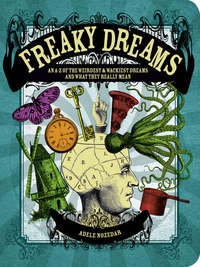
Полная версия
The Element Encyclopedia of Secret Signs and Symbols: The Ultimate A–Z Guide from Alchemy to the Zodiac
BLAZING STAR
See Pentagram and Freemasonry.
BOLINE

The boline is a knife in the Druid and Wiccan tradition. Its specific symbolism is held within its blade, which is shaped like the crescent Moon and is silver in color. The boline usually has a white handle, also in deference to the Moon.
This boline is a practical, ceremonial tool often used for cutting herbs either for magical uses or simply for cooking. In the case of the druid, it is also used for cutting mistletoe directly from the tree.
BOOK

It might seem as though the book is such a commonplace object that it should not really have much significance as a secret symbol. However, this isn’t the case. Take, for example, the High Priestess card in the Tarot. The Priestess holds a book or scroll, half concealed within the folds of her robe. Here, the book symbolizes knowledge and hidden secrets, and in a wider sense the book symbolizes the very Universe itself. There are also parallels with the book and the Tree of Life; like a tree, the book has “leaves” that represent individual ideas and concepts and that collectively represent the sum total of all knowledge, occult or otherwise.
If we delve into word meanings, we find more analogies between books and trees. The etymology of “book” comes from the Old English bokiz, or the Germanic buche, meaning beech. This is likely to be because runes were initially inscribed on beechwood tablets. Similarly, the word “library,” originally meant the “inner bark of trees.”
A book that is closed is a book that conceals its secrets; sometimes we refer to an inscrutable person as a “closed book.” An open book is the opposite, ready to share its information with all and sundry.
The Book of the Dead, for the Ancient Egyptians, was the series of magical charms that were interred with the dead in order that they might journey safely into the next world, and that would provide answers to the questions posed by those casting judgement on the soul. This book, effectively, symbolizes the secrets of the divine that are revealed only to those who have undergone the ultimate initiation: death. The Book of Shadows is a sort of recipe book of spells, charms, and rituals, generally belonging to the Wiccan practitioner, written by hand and often in code. This book is the personal property of its owner, and can be a series of traditional texts as well as a personal journal, containing secrets that are passed down from generation to generation.
BRIGHIDS CROSS

Corn dollies are frequently constructed in the shape of Brighids Cross, and although the symbol itself predates Christianity, it was given the name of the saint in order to ease the passage of acceptance of the new religion.
The symbol is reminiscent of the ancient Sun symbol, the swastika, its four arms pointing to the cardinal points of the compass. They also represent the Elements, with the point at the center indicating the fifth element or quintessence.
BROOMSTICK

The hard and polished elm wood that is traditionally believed to make the handle of the witch’s broomstick would help to make it more aerodynamic.
The broomstick, at first, appears to be a simple piece of household equipment. Its form may have changed over the centuries from the traditional dried branch of the broom plant (hence the name) but its use seems to have remained unchanged. However, there’s far more to it than that. The very act of sweeping was a sacred task in temples, since to be able to clean something properly the person doing the cleaning must himself be both clean and pure.
As well as sweeping away dust and dirt, symbolically the besom or broomstick sweeps away other things too; in parts of France, for example, it’s considered bad form to sweep up after dark in case good luck is swept away with the dirt. In Ancient Rome special broomsticks were used by sacred “midwives” or wise women to symbolically sweep away any negative influences from a house in which a baby had just been born. These broom-wielding midwives are the precursor to the witch that popularly flies about on a broomstick, which has to be the ultimate carbon-neutral vehicle.
The broomstick of the female witch is a very handy object to have around. It is often seen as a phallic symbol, and in pre-Christian societies marriages were often validated by the happy couple leaping together, hand in hand, over the broomstick. It is also a symbol of the liberation of the woman away from domestic drudgery; with her magical broomstick, the witch can fly anywhere, wield her power, and disclose her true identity.
Incidentally, the broomstick is sometimes called a “besom;” this word originates from the old English besema, meaning “woman,” and has the same root as the word “bosom.”
BULL ROARER

An important ritual object for Native Americans, Eskimos, Africans, and the Australian Aborigines, for whom the object is associated with the Churinga.
The Bull Roarer is a long, narrow piece of wood with tapering ends that, when attached to a cord and whirled around the head, produces a sound very much like thunder or the bellowing of a bull. It was taboo for woman to see this sacred object, which was used in initiation ceremonies and was regarded as carrying the actual voices of the Spirits.
The Bull Roarer was thought to make men invincible and indeed the noise it produces is quite terrifying, especially if it is not expected. It was also used in fertility rites and as a way of calling for rain.
BULLA
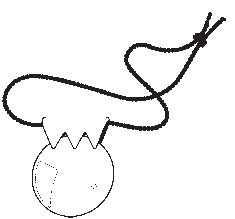
This is a special charm or amulet that was given to Roman children when they were born. A sealed locket, the bulla (meaning “bubble” or “knob”) contained magical spells specific to the child in question, such as symbols of protection, or wishes for wealth. The bulla was constructed of different materials depending on the wealth of the family, leather for the poorest families and gold or other precious metals for the wealthiest.
Roman boys put aside their bullae when they reached puberty, and the object was offered to the Gods. Girls wore theirs until the eve of their wedding. In either case it was considered that the bulla belonged to the child, as part and parcel of their personality.
The bulla is the origin of the name of the Papal Bull, the special edict that hails from the Vatican, which is fastened with an oval seal of the same shape as the bulla.
CADUCEUS

A rod, staff, or wand generally surmounted with wings. Two serpents entwine about the staff, forming a figure-of-eight shape. The key elements of the construction of this ancient sign are the serpent, the spiral, the infinity sign, the circle, wings, and the wand.
The Caduceus is an extremely ancient symbol, and its earliest recorded appearance is on the goblet of the King of Lagash, dating back some 2600 years BC.
The Caduceus is the emblem of Mercury/Hermes and is incredibly rich in meanings: first, the staff or wand is a symbol of power and authority, of magical and supernatural forces, and is the tool of all magicians, medicine men, and shamans. It also represents the Tree of Life or World Axis. Then there are the wings on top of the wand.
Wings signify flight (both physical and metaphorical), intuition, the spiritual, and communication from the Heavens or the Gods. Mercury is the Messenger of the Gods. The two serpents, twining in opposite directions, represent opposition and equilibrium. They also signify opposites—male and female, day and night, good and evil, and so represent balance. Serpents also remind us of hidden knowledge.
As the serpents scroll around the wand, they form the figure-of-eight shape, or infinity symbol, which stands for completeness and perfection.
Part of the infinity symbol is the circle, ultimately representing the cosmos, the spirit, and unity.
All these elements combined make for a powerful symbol that has altered very little over the millennia. Together, they add up to supernatural power and hidden wisdom, messages from the spiritual realms, authority, the cosmos and infinity, and the pairing of opposites in harmony and unity.
Perhaps the most common use of the Caduceus, both today and since its earliest appearance, is as a symbol of healing and medicine. Aesclepius, the first physician and the God of medicine, had the Caduceus as one of his attributes because he had the power and the intuition (the wand and the wings) to be able to use potentially poisonous or corruptive substances (the serpents) to restore health and, reputedly, to bring the dead back to life.
The Caduceus was not only the instrument of Aesclepius, but of the healing God Ningishzida of Mesopotamia (whose symbol is intertwining snakes), and of the Egyptians Ba’al, Isis and Ishtar. It is also found in India where it carries the same meaning.
CAGLIOSTRO SEAL

This curious sigil, the image of a snake, impaled by an arrow but with an apple in its mouth, presses all sorts of symbolic buttons; all three elements of the seal are powerful emblems in themselves. Is this the snake that tempted Eve with the apple, being punished for its transgressions? The snake also makes a curious S shape; is this significant, and if so, how? In addition, the union of the line of the arrow and the serpent seems to make a lemniscate, or figure-of-eight, symbol, meaning infinity. Unfortunately, it seems as though the precise meaning of the seal died with its namesake.
Cagliostro himself seems to be as mysterious as his seal. The self-styled Count Alessandro di Cagliostro was actually born as the much less grand-sounding Guiseppe Balsamo, and lived in Italy in the eighteenth century. The rumors surrounding his life and adventures come thick and fast and there is very little that is known for certain, due in no small part to the dense forest of fantastical stories that Cagliostro seems to have hidden himself within. He said that he had been born into the nobility but for some reason was abandoned on Malta, whereupon he wandered, as a child, throughout Morocco and Egypt where he learned many arcane mysteries, including those of the Kabbalah and alchemical magic. Whatever the truth, he certainly had skills as a pharmacist. It seems that the secure advantages of regular employment held no attraction for the Count, his attention being much more drawn to magical and mystical matters. He became a maker and vendor of magical amulets and talismans, and later, forgeries, including letters, certificates, and a myriad of official documents. He also offered the sexual favors of his beautiful young wife as trade for instruction in forgery.
Cagliostro’s seal has been the result of much analysis and conjecture, its appearance so convincing that it was even incorporated into an early Masonic-style organization called The Brotherhood of Luxor.
CALUMET

For the Plains Indians, the pipe, also called the calumet, is one of the most important and recognizable symbols. Although it is sometimes referred to as the Peace Pipe, shared ceremonially as part of a unifying ritual, the pipe was just as valid a symbol during times of war.
The tobacco used in the pipe is also a powerful magical substance originally intended for ritual use only. The smoke rising from the pipe signifies a prayer traveling toward the Gods and symbolizes the sacred breath, source of all life. The fire that lights the pipe symbolizes the Sun and the male element. The pipe itself is equivalent to the prayer that is offered up from it.
The calumet is considered so important that in Native American tradition it is described as though it were a person, and each of its components has the name of a body part. In addition, the bowl is described as an altar, and the stem, the passage of the breath extending from the human body.
CANCELLARIUS SEAL

This is one of the symbolic seals of Aleister Crowley’s Astrum Argentum, or Silver Star order. As the name suggests, it indicates the position of Chancellor. The symbol shows an Eye of Horus at the center of rays that are set in 12 groups of 3.
The Astrum Argentum was started by Crowley in 1907 as an alternative to MacGregor Mathers’ Golden Dawn. Although he had initially been enamored of the Golden Dawn and its charismatic leader, it is fair to say that Crowley liked to do things his own way, resulting in his expulsion from the Golden Dawn. Crowley believed that his own personal angel, Aiwaz, approved of his decision to supplant Mathers’ brotherhood. The unusual structure of the Astrum Argentum was typical of Crowley’s desire to be different. Each member was supposed to know only his immediate superior and anyone he introduced into the Order. For Crowley, the sole purpose of the Astrum Argentum was to disseminate his own teachings and mystical beliefs. It was assumed that anyone introduced into the Astrum Argentum would already have had a great degree of magical training, in contrast to the Golden Dawn, which was dedicated to teaching.
CANDLE
A candle symbolizes light in the darkness in a way that a light-bulb simply cannot do. A candle
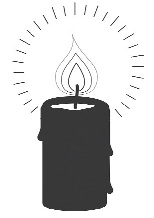
represents the element of fire as a benevolent force, made even more powerful if the candle is made of wax, a substance made by a magical creature, the bee. The colors of candles are significant in magical practices: for example, pink is said to attract love. Black candles are used in dark magic.
CAULDRON
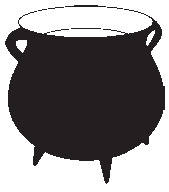
In understanding symbols, sometimes it is useful to simply look at the shape and see what it resembles. The traditional cauldron represents nothing so much as the belly of a pregnant woman and, unsurprisingly, the cauldron is an important female symbol all over the world. The circular shape of the cauldron gives another clue; the circle is a symbol of never-ending life and regeneration, and these themes recur repeatedly in stories containing cauldron symbolism.
The way the cauldron is used also gives a hint about its symbolic meaning. Things are put into the cauldron, heated, and something different is taken out; the basic ingredients are transformed. Therefore, the cauldron also symbolizes germination and transformation.
Traditionally, cauldrons have three legs. The number 3 in this instance represents the triple aspect of the Great Goddess, or the three fates. Shakespeare alludes to this when the three Weird Sisters—arguably the most famous witches in literature—cook up trouble at the beginning of Macbeth.
In pre-Christian literature, there are countless legends featuring magical cauldrons, and it may be because of this that the cauldron has its witchy associations. Celtic tales tell of cauldrons that contain an unending supply of food or of knowledge. The dead are frequently thrown into a magical Cauldron of Rebirth and climb out the next day, alive once more. Mythical warriors and heroes who died in battle are restored to life in this way. Ceridwen had a cauldron full of inspiration and magical powers. In India, a magic life-giving food, called Soma, was brewed in three huge bottomless cauldrons.
In Greece, there are tales in which an ordeal of initiation involves the person boiling in a cauldron, but after the rite, the initiate emerges with magical powers, including the gift of immortality.
CELTIC CROSS AND SUN CROSS SYMBOL

In the Celtic Cross or Ring Cross symbol, a cross is contained within a circle. Very early versions of this cross, found in Ireland, do not show the arms of the cross protruding beyond the circle; the whole symbol is encompassed inside the circle and in this case it becomes the ancient, universal symbol called the Sun Cross, the Wheel Cross, or Odin’s Cross. This sign first appears at the very start of the Bronze Age. Among other things, it symbolizes the wheel and in China represents thunder, power, and energy. It also appears in the seal of the Babylonian Sun God, Shamash.
The Sun Cross symbol also appears in ancient astrology. In modern astrology it still signifies the planet, and element of, Earth; the cross represents the four corners of the planet, the elements, and the directions, and the circle is the planet itself.
Because it was the symbol of the Sun, the King and the highest temporal and spiritual powers, it was easy for the early Christians to adopt this pagan sign and incorporate it into the Latin Cross. It is still used by Bishops to “bless” a new church, drawn onto the walls in sanctified water or oils, at twelve different places around the church.
The Celtic Cross is frequently used as a grave marker, or as a war memorial, particularly in Celtic countries.
Incidentally, the Hot Cross Bun, eaten specifically at Easter and popularly believed to represent the Christian Cross, is actually of pre-Christian origin. The Greeks, Romans, and Ancient Egyptians all ate wheat cakes to celebrate the coming of spring. These cakes were circular (representing the Moon or Sun) with a cross that divided the cake into the four lunar quarters or the four seasons.
CELTIC KNOTWORK
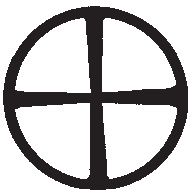
One of the most distinctive decorative features of Celtic artwork and architecture are the beautiful constructions of Celtic knotwork. It adorns stonework, illuminated manuscripts, and jewelry; the knotwork has left a distinctive trail that clearly shows all the places in the world that were visited at some point by the Celts.
The knotwork itself would appear to be a purely decorative device. If at one time there were specific symbolic meanings attached, then these have been lost over the centuries. Intertwining shapes and lines, however, generally point toward ideas of connectedness and the harmonious convergence of opposites, male and female, fire and water, Heaven and Earth, for example. In addition, any sign that can be made without the pen leaving the paper tends to have strong protective associations, and knotwork, with its continual looping and spiraling, could have been used in this way, perhaps used for amulets and talismans.
Existing symbols—such as a heart, or birds and animals—are often rendered in Celtic knotwork. In this case, the form of the underlying shape carries the symbolic meaning.
The Celtic Knot that is square in form is a protective symbol, called a shield knot.
CHA CHA
In Haiti, there are certain seed pods called cha cha that are used to make rattles for ceremonial musicmaking in Voudon rituals. The rattle is called a cha cha, too, and the dance of the same name also comes from the name of the seedpod.
See also Asson.
CHALICE
This is a cup or grail that is generally used in rituals. No matter what the religious or spiritual persuasion of the celebrant, a chalice of some

form is used, whether it be the highly ornamented vessel of the Catholic Church or the simpler wooden cup favored by some pagan groups. The chalice itself is symbolic of water or of the Spirit, and is used as such in the suit of Cups in the Tarot, for example. The chalice is also a universal symbol of the feminine aspect because of its shape, its use as a vessel, and its link with water.
Eastern religions use a kind of bell, called a Drilbu, in the place of a chalice.
CHAOS WHEEL

The Chaos Wheel, or Chaos Star, is a wheel constructed from eight arrow-headed spokes. Representing the notion of infinite possibilities, the symbol is a recent addition to a veritable galaxy of meaningful shapes. Designed by science fiction writer Michael Moorcock, it has been adopted as an emblem by exponents of Chaos Magic, the contemporary branch of magic inspired by the works of Austin Osman Spare.
CHESS
Chess originated in India. The checkerboard that chess is played on is, in itself, a secret symbol. It is symbolic of the world that we understand, that is composed of opposing forces. Also, the black and white colors of the symmetrically arranged squares stand for male/female, light/dark, positive/negative, good/evil in much the same way as the yin-yang sign does. It is no accident that the floor of the Freemason temple has the same construction as the chessboard, a constant reminder of both the harmony and tension between opposites. The pieces, too, are black and white, reinforcing this idea.
The chessboard has a further mystery that can be revealed in the number of the squares. Each side has eight squares. Eight is the number of infinity and of completion, and eight times eight makes 64, the number of cosmic unity. This is the magical number that, in sacred geometry, is the basis of temple construction.
The square shape of the board symbolizes the stability of the Earth and its four corners, the directions and the elements.
Superficially, chess might seem to be a relatively straightforward game, a simple series of different moves ascribed to each of the pieces. However, its complexities are only really revealed when the player is so familiar with the rules that he or she can carry them out automatically. Chess is plainly connected to war strategy and the ability to surprise the opponent. A good player will understand the need to sacrifice pieces in order to gain a greater advantage. Although the pawn may appear to be valueless, it is arguably one of the most important pieces on the board, and certainly the most prolific. We even use the word “pawn” to describe a person that we think is insignificant.


